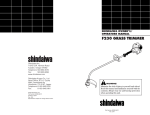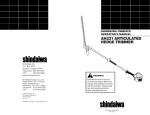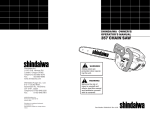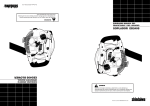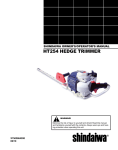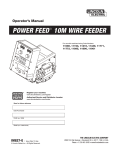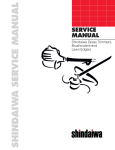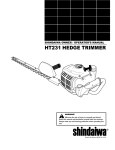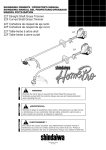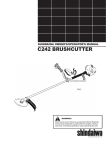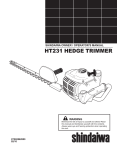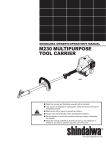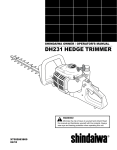Download Sherwood RX-4109 Stereo Receiver User Manual
Transcript
Part Number 80775 Rev. 9/03
姞
Minimize the risk of injury to yourself and others! Read this
manual and familiarize yourself with the contents. Always wear
eye and hearing protection when operating this unit.
WARNING!
SHINDAIWA MANUAL DEL
PROPIETARIO/OPERADOR
CORTADORA DE SETOS HT231
HT231 HEDGE TRIMMER
SHINDAIWA OWNER’S/
OPERATOR'S MANUAL
¡ADVERTENCIA¡
Minimize el riesgo de accidentes contra usted u otras personas. Lea este manual y familiaricese con sus contenidos.
Siempre utilice protección para los ojos y oídos cuando la
máquina sea usada.
Part Number 80775 Rev. 9/03
Introducción
Advertencias de seguridad
ESPAÑOL
La cortadora de setos Shindaiwa serie
HT231 ha sido diseñada y construida para
¡ADVERTENCIA!
suministrar rendimiento superior y
Una declaración precedida por el
seguridad sin comprometer calidad,
símbolo triangular de advertencia y la
comodidad o durabilidad.
palabra ¡ADVERTENCIA! contiene
Los motores de alto rendimiento
información o procedimientos que se
Shindaiwa representan la tecnología líder
deben cumplir para prevenir lesiones
en motores de 2-tiempos, de cilindrada y
graves.
peso notablemente bajos que desarrollan
suma potencia. Como dueño/operario,
¡PRECAUCIÓN!
usted muy pronto descubrirá por que
Shindaiwa, simplemente, es la única en su
Una declaración precedida por la
clase.
palabra ¡PRECAUCIÓN! contiene
información o procedimientos que se
¡IMPORTANTE!
deben cumplir para evitar dañar la
!La información contenida en este
máquina.
manual describe las máquinas
disponibles en el momento de
¡IMPORTANTE!
publicación!
¡Una declaración precedida por la
Aunque todo esfuerzo se a hecho
palabra ¡IMPORTANTE! denota
para proveerle la más reciente
información esencial o especial.
información sobre su producto Shindaiwa, podría haber algunas diferencias
entre su cortadora de setos HT231 y las
descritas en este manual. Shindaiwa
Inc. se reserva el derecho de hacer
cambios a sus productos sin notificación
previa y sin obligación alguna de hacer
alteraciones a máquinas previamente
fabricadas.
¡ADVERTENCIA!
Las emisiones liberadas por este
producto contienen substancias
químicas que en el estado de
California son consideradas como
causantes de cáncer, defectos
congénitos u otros efectos nocivos a
la reproducción humana.
Lea y siga las recomendaciones
en este manual. De no hacerlo
lo podria sufrir lesiones graves.
Use proteccion para los ojos
aprovada por la norma ANSI Z87.1
v proteccion para los oidos en
todo momento que esta operando
esta maquina.
Manipule con mucho cuidado.
las cuchillos estan bien afiladas.
Maintenga ambas manos
distanciadas de las cuchillas
al encender y operar esta maquina.
ADVERTENCIA! La superficie puede
estar caliente. Siempre use guantes
cuando toque esta máquina.
¡IMPORTANTE!
La intención de los procedimientos
operacionales descritos en este manual
es ayudarle a obtener el más alto
rendimiento posible de su máquina y
proteger a usted y otras personas de
sufrir lesiones graves. Estos
procedimientos son pautas operativas
para operaciones seguras bajo la
mayoría de condiciones y no tienen el
propósito de substituir las normas
vigentes en su área.
Si usted tiene alguna pregunta en
relación a su cortadora de setos HT231
o no entiende algo en este manual, su
distribuidor Shindaiwa estará muy
contento en atenderlo. También puede
ponerse en contacto con Shindaiwa Inc.
en la dirección impresa al inverso de
este manual.
Contenido
PAGINA
IMPORTANT!
The operational procedures described in
this manual are intended to help you get
the most from your unit, and to protect
you and others from harm. These
procedures are guidelines for safe
operation under most conditions, and
are not intended to replace any safety
rules and/or laws that may be in force in
your area.
If you have questions regarding your
HT231 hedge trimmer, or if you do not
understand something in this manual,
your Shindaiwa dealer will be glad to
assist you. You may also contact
Shindaiwa, Inc., at the address printed
on the back of this manual.
Introducción ............................................... 2
Advertencias de seguridad ....................... 2
Instrucciones Generales de Seguridad ... 3
Etiquetas de seguridad ............................. 4
Descripción del producto ......................... 5
Especificaciones ........................................ 5
Combustible ............................................... 6
Llenado del tanque .................................... 6
Instrucciones de arranque ....................... 7
Ajuste de marcha mínima ......................... 8
Parada del motor ....................................... 8
Mantenimientos y ajustes ........................ 9
Almacenamiento ...................................... 11
Guía diagnóstico ...................................... 12
Declaración de la garantía del sistema de
control de emisiones ............................... 15
PAGE
IMPORTANT!
A statement preceded by the word
IMPORTANT is one that possesses
special significance.
A statement preceded by the word
"CAUTION" contains information that
should be acted upon to avoid
damaging your unit.
CAUTION!
A statement preceded by the triangular Attention Symbol and the word
"WARNING" contains information that
should be acted upon to prevent
serious bodily injury.
WARNING!
WARNING! Surface can
be hot. Always wear
gloves when handling
this unit.
Keep hands clear of the
cutter blades when
starting the engine.
The blades are SHARP!
Handle with care.
Wear eye and hearing
protection at all times
during the operation of
this unit.
Read and follow this
operators manual.
Failure to do so could
result in serious injury.
Attention Statements
2
ENGLISH
2
Emission System Warranty .................... 15
Troubleshooting Guide .......................... 12
Storage ...................................................... 11
Maintenance and Adjustments ................ 9
Stopping the Engine .................................. 8
Idle Speed Adjustment .............................. 8
Starting the Engine ................................... 7
Filling the Fuel Tank ................................ 6
Mixing Fuel ................................................ 6
Specifications ............................................. 5
Unit Description ........................................ 5
Safety Labels .............................................. 4
General Safety Instructions ...................... 3
Attention Statements ................................. 2
Introduction ............................................... 2
Contents
The engine exhaust from this product
contains chemicals known to the
State of California to cause cancer,
birth defects or other reproductive
harm.
WARNING!
The Shindaiwa HT231 hedge trimmer has
been designed and built to deliver
superior performance and reliability
without compromise to quality, comfort,
or durability.
Shindaiwa high performance engines
represent the leading edge of 2-cycle
engine technology, delivering exceptionally high power at remarkable low
displacement and weight. As an owner/
operator, you’ll soon discover for yourself
why Shindaiwa is simply in a class by
itself!
IMPORTANT!
The information contained in this manual
describes units available at the time of
publication.
While every attempt has been made
to give you the very latest information
about your Shindaiwa product, there
may be some differences between your
HT231 hedge trimmer and what is
described here. Shindaiwa Inc. reserves
the right to make changes to products
without prior notification, and without
obligation to make alterations to units
previously manufactured.
Introduction
3
Instrucciones Generales de Seguridad
NEVER run the engine when transporting the unit.
NEVER run the engine indoors! Make
sure there is always good ventilation.
Fumes from engine exhaust can
cause serious injury or death.
ALWAYS clear your work area of
trash or hidden debris that could be
thrown back at you or toward a
bystander.
ALWAYS use the proper cutting tool
for the job.
ALWAYS stop the unit immediately if
it suddenly begins to vibrate or shake.
Inspect for broken, missing or
improperly installed parts or attachments.
ALWAYS hold the unit firmly with
both hands when cutting or trimming,
and maintain control at all times.
ALWAYS keep the handles clean.
ALWAYS disconnect the spark plug
wire before performing any maintenance work.
Cortadoras de setos operan en altas
velocidades y pueden causar daños o lesiones
serias si son malusadas o abusadas. Nunca
permita que una persona sin entrenamiento o
instrucción opere esta unidad !
¡ADVERTENCIA!
Nunca instale accesorios de corte no
autorizados.
Mantengase Alerta
Debe de estar física y mentalmente en
optimas condiciones para operar esta
máquina con seguridad.
¡ADVERTENCIA!
Figure 1
Avoid cutting large or extremely “woody” branches.
Doing so can shorten cutter life, and may also
damage the gearcase.
Use extreme caution when
operating near fences or
electric wiring.
Always keep proper footing and do not
overreach. Maintain your balance at all
times during operation.
Never cut metal objects or
wire with the blade.
HT231_17
Never operate this unit
at full throttle no-load
rpm!
Always stop the
engine before
removing branches or
debris from the
cutters! Never allow
the cutters to contact
buildings or other
hard objects!
Never operate this
unit if the safety
guard has been
removed or
damaged!
Always operate with
both hands firmly
gripping the unit.
Always wear close-fitting clothing. Gloves offer
added protection and are strongly recommended.
Do not wear clothing or jewelry that could get
caught in machinery.
Never allow children to use the
unit. Avoid operating near
bystanders.
ENGLISH
No opere esta herramienta si esta
cansado, enfermo o ha consumido
bebidas que contienen alcohol, drogas o
medicamentos.
¡ADVERTENCIA!
Disminuya El Riesgo de
Incendios.
NUNCA fume ni encienda fuegos cerca
del motor.
SIEMPRE pare el motor y permita que se
enfrie antes de volver a llenar el tanque.
Evite sobre llenar el tanque y limpie
cualquier derrame de combustible.
SIEMPRE : Inspeccione la máquina por
pérdidas de combustible, antes de cada
uso. Durante cada llenado, verifique
posibles pérdidas alrededor de la tapa o
tanque de combustible. Si existen
pérdidas de combustible evidentes, pare
inmediatamente de utilizar la máquina.
Pérdidas de combustible deben de ser
reparadas antes de cada uso.
SIEMPRE aleje la máquina del área de
combustible o de otros materiales
inflamables antes de arrancar el motor.
NUNCA coloque materiales inflamables
cerca del silenciador de la máquina.
NUNCA opere el motor sin la malla del
guardachispas en su lugar.
Use siempre ropa ceñida al cuerpo. Use guantes
de trabajo para incrementar el nivel de
protección. No use ropa o joyas que pudieran
enredarse en la máquina. Cerciórese de que el
cabello no le pase de los hombros.
Siempre use protección
para los ojos, los oídos y las
manos cuando trabaja con
esta máquina.
Siempre detenga la
marcha del motor
antes de retirar
ramas o residuos
de las cuchillas.
Nunca permita que
las cuchillas hagan
contacto con
edificaciones u
otros objetos
sólidos.
Nunca permita que niños usen
está máquina. Evite usarla cerca
de transeúntes.
ESPAÑOL
Trabaje con cuidado
ALWAYS wear eye protection to
shield against thrown objects.
ALWAYS protect yourself from
hazards such as thorny brush and
flying debris by wearing gloves and
close fitting clothing that covers arms
and legs. Never wear shorts. Don’t
wear loose clothing or items such as
jewelry that could get caught in
machinery or underbrush. Secure
long hair so it is above shoulder level.
WARNING!
Use Good Judgment
NEVER smoke or light fires near the
engine.
ALWAYS stop the engine and allow
it to cool before refueling. Avoid
overfilling and wipe off any fuel that
may have spilled.
ALWAYS move the unit to a place
well away from a fuel storage area
or other readily flammable materials
before starting the engine.
NEVER place flammable material
close to the engine muffler.
NEVER run the engine without the
spark arrester screen in place.
Minimize the Risk of Fire
WARNING!
Avoid using or storing
this unit in a wet
environment. Water on
the cutters may enter
the gear-case and
damage your unit.
Always stop the engine
and install the blade cover
before moving to another
work site, and maintain a
firm footing while operating
or carrying the trimmer.
Never operate power equipment of
any kind if you are tired or if you are
under the influence of alcohol, drugs,
medication or any other substance
that could affect your ability or
judgement.
WARNING!
You must be physically and mentally fit to
operate this unit safely.
Stay Alert
Never make unauthorized attachment
installations.
Always wear eye, ear, and
hand protection while
operating this unit!
WARNING!
Shindaiwa hedge trimmers operate at very
high speeds and can do serious damage or
injury if they are misused or abused. Never
allow a person without training or instruction to
operate your unit!
Work Safely
WORK SAFELY!
Nunca opere esta
máquina a velocidad
máxima sin carga.
Nunca opere esta
máquina si el
protector para la
mano está
quebrado.
Siempre sujete la
máquina firmemente
con ambas manos.
HT231_17
Siempre detenga la
marcha del motor e instale
la vaina protectora en las
cuchillas antes de llevarla a
otra área de trabajo y
mantenga su balance sobre
el suelo mientras trabaje o
lleva la recortadora a
mano.
Evite usar o guardar esta
máquina en sitios húmedos. El
depósito de agua en las
cuchillas podría penetrar en la
caja de engranaje y dañar su
máquina.
Siempre manténgase
parado sobre tierra firme y
no sobre extienda el cuerpo.
Mantenga su equilibrio en
todo momento que esté
operando la máquina.
Nunca corte objetos
metálicos o alambre.
Ejercer extrema cautela
cuando trabaje en la
próximidad de cercas o
alambrados electricos.
Evite cortar ramas grandes o demasiado “leñosas”.
De lo contrario, podría acortar la vida útil de las
cuchillas y/o dañar la caja de engranajes.
Figura 1
¡ADVERTENCIA!
Use Buen Juicio
Siempre use protección para los
ojos tal como lentes de
seguridad para protegerse de
objetos lanzados.
Use ropa de su talla para protejer
su piernas y brazos. Los
guantes siempre proveen
protección adicional y son
altamente recomendados. No
use ropa holgada o joyas que
puedan atascarse en la máquina
o en la vegetación. Amárrese el
cabello largo de tal forma que
esté sobre el nivel de los
hombros.
NUNCA opere el motor cuando
transporte la unidad.
NUNCA opere el motor en el interior!
Cerciorese que siempre haya buena
ventilación. El humo o gases del
escape del motor pueden causar
serias lesiones o la muerte.
SIEMPRE pare el motor
inmediatamente si repentinamente
empieza a vibrar. Inspeccione el
accesorio de corte por partes
quebradas, faltantes o instaladas
incorrectamente.
SIEMPRE sujete la máquina
firmemente con ambas manos
cuando corte o recorte, y mantenga
el control en todo momento.
SIEMPRE mantenga los mangos
limpios.
General Safety Instructions
3
Equipo de Seguridad y etiquetas
4
ESPAÑOL
¡IMPORTANTE!
Etiquetas de Cuidado, Peligro, Advertencia
e Información de Funcionamiento:
Asegurese de que todas las etiquetas de
información no esten dañadas y que sean
legibles. Reemplace inmediatamente
cualquier etiqueta de informacion que falte o
que este dañada. Puede obtener etiquetas
nuevas de su agente local autorizado
Shindaiwa.
Etiqueta de Precaución
Cubierta para las cuchillas
Interruptor de
marcha
HT231_1
Protector
Trabador del gatillo
de aceleración
Figure 2
Etiqueta de Precaucion
Caution Label
Figura 2
Throttle Interlock
Protector
HT231_1
ENGLISH
ON-OFF
Switch
Caution Label
Cover
IMPORTANT!
Caution, Danger, Warning, and Operation Information Labels:
Make sure all information labels are
undamaged and readable. Immediately
replace damaged or missing information
labels. New labels are available from
your local authorized Shindaiwa dealer.
Safety Equipment and Labels
4
5
Specifications are subject to change without notice.
Model ..................................................................................................... HT231-30/HT231-40
Engine Model ............................................................................................................. SHT231
Engine Type ............................................................ 2-cycle, horizontal cylinder, air cooled
Engine Bore x Stroke .................................................................................... 32mm x 28mm
Engine Displacement .................................................................................................... 22.5cc
Unit Weight, Less Fuel .............................................................. HT231-30: 5.9kg (13.01 lb)
................................................................................................. HT231-40: 6.4kg (14.11 lb)
Unit Dimensions (LxWxH) ................................................. HT231-30: 990 x 210 x 210mm
......................................................................................... HT231-40: 1330 x 210 x 210mm
Max. Power .................................................................................. 1.1 hp @ 8000 rpm (min-1)
Fuel/oil ratio ...................... 50:1 with *ISO-L-EGD or JASO FC class 2-cycle Mixing Oil
Fuel Tank Capacity ........................................................................................ 0.7 liter/24 oz.
Carburetor ............................................................................. Walbro WYJ, Diaphragm type
Ignition ..................................................................... Fully electronic, transistor controlled
Spark Plug ..................................................................................................... Champion CJ8Y
Air Cleaner ....................................................................................................... Foam element
Muffler Type .................................................................................................. 2-stage catalyst
Starting Method .................................................................................................... Recoil type
Stopping Method ..................................................................... Slide switch,grounding type
Blade Length ......................................................... HT231-30: 740mm; HT231-40: 1080mm
Blade Type ............................................. Double-blade cutting action: single-edged blade
Clutch Type ............................................................................... Centrifugal clutch, dry-type
Gear Type ............................................................................................................... Spur gears
Gear Lubrication ................................................................................. Lithium-based grease
Standard Equipment ............... Rear handle with integral controls, anti-vibe mountings.
................................... Front handle with guard. Tool set and blade scabbard (cover).
Options .......................................................................................................... Deflector shield
**EPA Emission Compliance Period .................................................................... Category A
Specifications
Figure 3
Fuel Tank
Gearcase
Air Cleaner
Cover
Choke
HT231_2
ON-OFF Switch
Throttle Trigger
Descripción del Producto
Guiándose por las ilustraciones
familiarícese con su máquina y los varios
componentes. Conociendo su máquina le
ayudara obtener alto rendimiento, vida de
servicio más prolongada y trabajar con
seguridad.
¡ADVERTENCIA!
No modifique o altere esta máquina,
los componentes o accesorios sin
autorización previa.
Antes de usarla
Bastidor de
Mango delantero
cuchillas
Arrancador
Mango
trasero
Cuchillas
Protector
Deflector de
escape
Tapa de
llenado de
combustible
Leva del
estrangulador
Interruptor de
marcha
Gatillo de
aceleración
Protector
para las
cuchillas
Antes de comenzar el ensamblaje de este
producto, cerciórese de tener todos los
componentes necesarios para ensamblar
una máquina completa:
HT231_2
■ Motor con caja de engranaje/cuchillas
■ Llave de bujía/llave de 13mm y
destornillador pequeño.
Cubierta del
filtro de aire
Inspeccione cuidadosamente todos los
componentes en búsqueda de daños.
¡IMPORTANTE!
Los términos “izquierda”, “a mano
izquierda” e “IZQUIERDA”, “derecha”,”a
mano derecha” y “DERECHA”,
“delantera” y “trasera”, indican
direcciones desde el punto de vista del
operador durante la operación.
Fuel Cap
Rear Handle
Cover
Exhaust Deflector
Recoil
Starter
Front Handle
Guide Bar
ENGLISH
ESPAÑOL
** The EPA emission compliance
referred to on the emission compliance
label located on the engine, indicates the
number of operating hours for which the
engine has been shown to meet Federal
emission requirements. Category C = 50
hours (Moderate), B = 125 hours (Intermediate) and A = 300 hours (Extended).
*Shindaiwa ONE is a registered JASO FC
classified oil and also meets or exceeds
ISO-L-EGD performance requirements.
IMPORTANT!
The terms “left,” “left-hand,” and “LH”;
“right,” “right-hand,” and “RH”; “front”
and “rear” refer to directions as viewed
by the operator during normal operation
of this product.
Carefully inspect all components for
damage.
■ Combination spark plug/13mm wrench
■ Engine assembly and gearcase/cutter
assembly
Before using this product, please make
sure you have all the components required
for a complete unit:
Prior to use
Do not make unauthorized modifications or alterations to this unit or to
any of its components or accessories.
Protector
*El aceite de mezclar Shindaiwa Premium
One cumple o excede esta especificación y
es recomendado para todos los productos
Shindaiwa.
WARNING!
Cutter
Using the accompanying illustrations as a
guide, familiarize yourself with your unit
and its various components. Understanding your unit helps ensure top performance, long service life, and safer
operation.
** Las normas de emisión EPA
mencionadas en la etiqueta localizada en el
motor de la maquina, indica el numero de
horas de operación las cuales cumplen con
los requerimientos de normas de emisión
federales. Categoria C=50 horas
(Moderado), B= 125 horas ( Intermedio)
y A= 300 horas (Extendidas).
Tanque de
combustible
Figura 3
Caja de
engranajes
Especificaciones
Modelo ................................................................................................... HT231-30/HT231-40
Modelo de motor ........................................................................................................ SHT231
Tipo de motor ......................................... 2-tiempos, cilindro horizontal, enfriado por aire
Diámetro x carrera ......................................................................................... 32mm x 28mm
Cilindrada ....................................................................................................................... 22.5cc
Peso neto, unidad completa sin combustible .......................... HT231-30: 5.9kg (13.01 lb)
................................................................................................. HT231-40: 6.4kg (14.11 lb)
Dimensiones de la cortadora de setos (longitud x ancho x altura) ...................................
....................................................................................HT231-30: 990 x 210 x 210mm
......................................................................................... HT231-40: 1330 x 250 x 210mm
Potencia ........................................................................................ 1.1 hp @ 8000 rpm (min-1)
Proporción de combustible/aceite .............. 50:1 con aceite de mezclar para motores de
2-tiempos ISO-L-EGD o JASO FC.
Capacidad del tanque de combustible .............................................................. 0.7 l./24 oz.
Carburador .......................................................................................................... Walbro WYJ
Sistema de encendido ......................................... Electrónico, controlado por transistores
Bujía: .............................................................................................................. Champion CJ8Y
Filtro de aire ............................................................................................................ Esponjosa
Tipo de Silenciador .......................................................................... Catalizador de 2 etapas
Metodo de arranque .............................................. Arrancador manual de resorte recular
Metodo de parada ............................................... Interruptor deslizante de puesta a tierra
Cuchillas Longitud ............................................... HT231-30: 740mm; HT231-40: 1080mm
Cuchillas Tipo ....................................................................... Doble Cuchillas, Lado Sigular
Enbrague ..................................................................... centrífugo, tipo seco de dos zapatas
Engranajes ............................................................................. Cilíndricos de dientes rectos
Lubricación ............................................................................................ Grasa a base de litio
Equipo estándard ...................................... Mango delantero con protector para la mano.
Mango trasero con control de aceleración, amortiguadores Juego de herramientas y
cubierta protectorapara las cuchillas.
**Regulaciones de Emisiones EPA ...................................................................... Categoria A
Especificaciones sujetas a cambio sin previo aviso.
Unit Description
5
Combustible
ESPAÑOL
¡PRECAUCIÓN!
Algunos tipos de gasolina contienen
alcohol como oxigenante. Combustible oxigenante prodría llegar a
causar temperaturas elevadas
durante la operación de la máquina.
Bajo ciertas condiciones, combustible
con base de gasolina podría también
reducir las cualidades de la
lubricación de algunos aceites
mezclas para motores de 2-tiempos.
Nunca utilice ningún tipo de gasolina
con más de 10% de alcohol por
volumen ! Aceites genéricos no
deberían ser utilizados para alto
rendimiento en motores de 2-tiempos,
y nunca deben ser utilizados en
motores Shindaiwa.
¡IMPORTANTE!
Mezcle el combustible necesario para
uso inmediato. Si tiene que almacenar
combustible por más de 30 días
agrégele aceite
con aditivo
estabilizador como por ejemplo Stabil™.
Llenado del tanque de
combustible
¡ADVERTENCIA!
¡Disminuya el riesgo de incendios!
■
■
es un aceite registrado JASO FC
que cumple con los requerimientos ISOL-EGD para major rendimiento. Shindaiwa one es recomendado para ser
utilizado en forma conjunta con las
máquinas de bajas emisiones. Shindaiwa
también incluye un estabilizador de
combustible.
■
■
■
¡PRECAUCIÓN!
Este motor está certificado para
funcionar únicamente con una mezcla
de combustible compuesta de
gasolina sin plomo y aceite de
mezclar para motores de 2 tiempos
ISO-L-EGD o JASO FC a proporción
de 50:1.
¡Siempre permita la cortadora
DH231 enfriar antes de volver a
llenar el tanque!
¡Limpie todo los derrames de
combustible. Aleje la cortadora a
por lo menos 3 metros (10 pies)
del lugar donde lleno el tanque y
del depòsito de almacenar combustible antes de arrancar el
motor!
¡Nunca fume ni encienda fuegos
cerca de la DH231 o del deposito
de almacenar combustible!
¡Nunca coloque material
inflamable cerca del silenciador!
¡Nunca opere la DH231 si el
silenciador y el guardachispas no
están instalados o si no estan
funcionando adecuadamente!
1. Ponga la cortadora de setos DH231 en
el suelo o sobre una superficie plana.
2. Limpie el polvo y los desechos de
cortes de la superficie de la tapa de
llenado de combustible.
3. Remueva lentamente la tapa de llenado
y llene el tanque con combustible
nuevo y limpio. ¡NO SE EXCEDA AL
LLENAR!
■ Utilice gasolina sin plomo nueva y
limpia, La gasolina debe tener un
grado de Octano de 87 o más alto.
■ Mezcle combustible con aceite mezcla
para motor de 2 tiemos enfriado por
air que cumplan o excedan ISO-L-EGD
y/o JASO JC a proporción de 50:1.
6
4. Reinstale la tapa de llenado y apriétela
firmemente.
Ejemplos de cantidades de mezcla 50 :1
4. Install and firmly tighten the fuel cap.
■ 1 galón de gasolina a 2.6 onzas de aceite
mezcla
■ 5 litros de gasolina a 100ml. de aceite
mezcla
■ 1 gallon of gasoline to 2.6 oz. mixing oil
■ 5 litres of gasoline to 100 ml. mixing oil
Examples of 50:1 mixing quantities
■ Use only fresh, clean unleaded
gasoline with a pump octane of 87 or
higher.
■ Mix all fuel with a 2-cycle
air-cooled mixing oil that meets
or exceeds ISO-L-EGD and/or JASO
FC classified oils at 50:1 gasoline/oil
ratio.
This engine is certified to operate on a
50:1 mixture consisting of unleaded
gasoline and ISO-L-EGD or JASO FC
class 2-cycle mixing oil only. Use of
non-approved mixing oils in catalyst
equipped units can lead to excessive
carbon deposits.
3. Remove the fuel cap, and fill the fuel
tank with clean, fresh fuel mixture.
2. Clear any dirt or other debris from
around the fuel filler cap.
1. Place the trimmer on a flat, level
surface.
CAUTION!
Oil is a registered JASO FC
classified oil and also meets or exceeds
ISO-L-EGD performance requirements.
Shindaiwa One is recommended for use
in all Shindaiwa low emissions egines.
Shindaiwa one also includes a fuel
stabilizer.
IMPORTANT!
Mix only enough fuel for your immediate
needs! If fuel must be stored longer than
30 days and
oil with fuel stabilizer
is not used, it should first be treated with
a fuel stabilizer such as StaBil™.
■ Always allow the trimmer to cool
before refueling!
■ Wipe all spilled fuel and move the
trimmer at least 10 feet (3 meters)
from the fueling point before
restarting!
■ Never smoke or light any fires near
the trimmer or fuel!
■ Never place any flammable
material near the engine muffler!
■ Never operate the engine without
the muffler and spark arrester in
place and properly functioning!
Minimize the risk of fire!
WARNING!
Filling the Fuel Tank
6
ENGLISH
Some types of gasoline contain
alcohol as an oxygenate. Oxygenated
gasoline may cause increased
operating temperatures. Under
certain conditions, alcohol-based
gasoline may also reduce the lubricating qualities of some 2-cycle mixing
oils. Never use any type of gasoline
containing more than 10% alcohol by
volume! Generic oils and some
outboard oils may not be intended for
use in high-performance 2-cycle type
engines, and should never be used in
your Shindaiwa engine.
CAUTION!
Mixing Fuel
7
Instrucciones de Arranque
¡IMPORTANTE!
El sistema de encendido lo controla un
interruptor deslizante de dos contactos.
El rotulo STOP aparece grabado en el
tope del botón del interruptor.
Bomba de cebado
(vista posterior)
HT231_10
Posición de
encendido
Botón del
Interruptor
HT231_8
Figura 4
1. Deslice el botón del interruptor hacia
la posición I (encendido).
Consulte Figura 4.
Figura 6
3. Oprima la bomba de cebado varias
veces hasta que sienta resistencia y
vea combustible fluir por la bomba.
Consulte Figura 6.
¡IMPORTANTE!
La bombilla de cebado solamente
empuja combustible a trav z del
carburador. Presionando repetidamente
la bombilla de cebado no ahogará el
motor con combustible.
Seguro del gatillo de
aceleración
Cuando el motor enciende o intenta
encender.
1. Mueva la palanca del estrangulador
hacia atrás para abrir el estrangulador.
2. Después que el motor arranca accione
el acelerador varias veces para
eliminar el exceso de combustible de
la cámara de combustión.
3. Si el motor se para, repita los
procedimientos aplicables para el
arranque de un motor frío o un motor
caliente.
¡ADVERTENCIA!
Las cuchillas se mueven al acelerar
el motor. Mantenga las manos y el
cuerpo distanciados de las cuchillas.
Operación
Botón
trabador
HT231_11
Estrangulador
cerrado
Figura 7
HT231_9
Gatillo de
aceleración
Figura 5
2. Trabe el gatillo de aceleración en la
posición de marcha acelerada según
las siguientes instrucciones.
4. (Motor frío)
Mueva la leva del estrangulador hacia
adelante ("closed") para cebar el
motor. Consulte Figura 7.
Arranque del motor
a. Oprima el gatillo de aceleración y el
seguro del gatillo de aceleración a la
misma vez.
b. Oprima el botón trabador y lentamente
suelte el gatillo y el seguro del gatillo
de aceleración a la misma vez.
¡ADVERTENCIA!
¡Manténga las manos y el cuerpo
alejados de las cuchillas en todo
momennto! Las cuchillas se moveran
al arrancar el motor.
■ Ponga la cortadora de setos sobre
el suelo durante todas las
operaciones de arranque.
■ Cerciórese de estar en posición
firme sobre el suelo y sujete la
máquina firmemente.
■ Mantenga a todos los niños,
transeúntes y animales
domésticos alejados de la
cortadora de setos durante todas
las fases de operación.
ESPAÑOL
■ Always rewind the starter cord
■ Never pull the starter cord to its
full length.
■ Always engage the starter before
attempting to crank the engine.
The recoil starter can be easily
damaged by abuse!
CAUTION!
3. Start the trimmer by pulling the
starting handle rapidly outward.
2. Pull the starter handle slowly toward
you until you feel the starter mechanism engage.
1. Place the unit on the ground. Grip the
engine cover with your left hand and
the starter handle with your right
hand (shown).
Figure 8
Fast Idle
Button
■ If the engine still fails to start, use the
procedures for “Starting a flooded
engine,” on the next page.
If the engine does not start–
Figure 7
HT231_11
Choke
Closed
IMPORTANT!
The primer system only pushes fuel
through the carburetor. Repeatedly
pressing the primer bulb will not flood
the engine with fuel.
Figure 6
Ignition ON
■ Releasing the throttle decreases
engine speed, causing the cutters to
slow, and then stop altogether as the
clutch disengages.
■ Squeezing the throttle increases
engine speed, causing the clutch to
engage and operate the cutters.
Operation
The cutting attachment will move
when the engine accelerates!
WARNING!
4. Operating the throttle will automatically disengage the fast idle setting.
3. When the engine starts, clear excess
fuel from the combustion chamber by
accelerating the engine several times
with the throttle lever.
HT231_10
1. Open the choke by moving the choke
lever backward (toward the fuel tank).
When the engine starts or fires–
ENGLISH
■ Keep all bystanders and pets well
clear of the trimmer during starting
operations.
■ Make sure you have a secure
footing, and keep a firm grip on the
unit as well.
KEEP CLEAR OF THE CUTTING
ATTACHMENT DURING STARTING
OPERATIONS! THE CUTTERS MAY
MOVE WHEN THE ENGINE IS
STARTED!
■ Place the trimmer on the ground
during all starting operations.
WARNING!
HT231_13
c. While depressing the fast idle button,
release the throttle lock and throttle
trigger.
■ Repeat the appropriate starting
procedure for a cold or warm engine.
b. Depress and hold the “fast idle”
button.
4. (Cold engine only) Choke the engine
■ Use a sweeping motion when cutting,
by moving the choke lever forward to
2. Set the throttle trigger to the “fast idle”
and vary throttle settings often.
the “closed” position. See Figure 7.
position by performing the following:
■ Avoid cutting material larger than 1/2
Cranking the Engine
a. Depress and hold the throttle lock, and
inch in diameter.
then squeeze the throttle trigger.
Figure 5
Throttle Trigger
HT231_9
Throttle
Lock
1. Move the ignition stop switch to the
right (towards the grip) to the “I” or
ON position. See Figure 4.
Figure 4
HT231_8
3. Prime the carburetor by repeatedly
depressing the carburetor primer bulb
until clear fuel can be seen flowing
through the transparent primer bulb.
Ignition
Switch
2. If the engine does not continue to run,
repeat the appropriate cranking
procedures for a cold or warm engine.
Primer Bulb (viewed
from rear)
IMPORTANT!
Engine ignition is controlled by a twoposition on-off switch mounted on the
throttle body. This switch is typically
labeled “I” for ON and “O” for OFF.
HT231_13
Figura 8
5. Ponga la máquina en el suelo. Sujete
el motor por la cubierta con la mano
izquierda y con la mano derecha,
empuñe el mango del arrancador.
Consulte Figura 8.
6. Jale el mango del arrancador
lentamente hacia afuera hasta que
sienta el mecanismo de arranque
engranar.
7. Jale el mango del arrancador
rápidamente hacia afuera para
arrancar el motor.
■ Al instante que el operario oprime el
gatillo de aceleracion, la marcha del
motor se acelera. La aceleración de la
marcha del motor causa que el
embrague acople con la caja de
engranajes, la cual acciona el
movimiento de las cuchillas.
■ La desaceleración de la marcha del
motor es inmediata al instante que el
operario libera el gatillo de
aceleración. La marcha del motor
vuelve a caer en marcha mínima y
causa que el embrague se desacople
de la caja de engranajes, la cual
detiene el movimiento de las cuchillas.
■ Los cortes se deben de llevar a cabo
con movimientos de lado a lado (cortes
laterales) o de arriba abajo (cortes
verticales) variando la marcha del
motor de acuerdo a la clase de seto
que corta.
■ Siempre se debe de evitar cortar setos
que tienen más de 1,3cm (1/2 pulg.)
de diámetro.
Si el motor no enciende–
■ Repita las instrucciones aplicables para
el arranque de un motor frío o caliente.
■ Consulte las instrucciones "Arranque
de un motor ahogado."
¡PRECAUCIÓN!
El arrancador le durara más si se
opera de acuerdo a las siguientes
recomendaciones.
■ Siempre engrane el arrancador al
comenzar el arranque del motor.
■ Nunca extienda la cuerda del
arrancador hasta el tope.
■ Permita que la cuerda vuelva
enrollar en el arrancador.
Starting Procedure
7
Arranque de un motor
ahogado
ESPAÑOL
¡ADVERTENCIA!
¡Riesgo de quemadura por el motor
caliente. Permita que el motor enfrie
antes de retirar la cubierta del
cilindro.
1. Deslice el botón del interruptor de
marcha hacia la posición “O” (parada).
Ajuste de la marcha mínima Parada normal del motor
La velocidad del motor debe de volver a
marcha mínima en todo momento que el
gatillo de aceleración se libera. La marcha
mínima es regulable y se ajusta, de
acuerdo a las especificaciones del motor,
para que el motor permita que el
embrague centrífugo se desacople de los
engranajes.
8
Parada (O)
Interruptor
de marcha
HT231_16
2. Afloje el tornillo captivo de la cubierta
del cilindro y retire la cubierta.
Figura 11
3. Desconecte el cable de la bujía , y
luego use la llave de bujías para aflojar
y retirar la bujía.
4. Si la bujía esta atorada o impregnada
con combustible, límpiela o
reemplácela según sea necesario.
Consulte la página 21 para las
especificaciones de la bujía y el
proceso de calibración.
1. Permita que el opere en marcha
mínima por dos o tres minutos para
que la temperatura del motor se
estabilice.
HT231_15
2. Mueva el botón del interruptor a la
posición O (apagado).
Consulte Figura 11.
Tornillo para ajustar la
marcha mínima
5. Una vez retirada la bujía, arranque el
Figura 10
motor varias veces para eliminar el
exceso de combustible en la cámara de Para ajustar la marcha mínima:
combustión.
¡PRECAUCIÓN!
La instalación incorrecta de la bujía
puede dañar el motor.
6. Reinstale la bujía y apriétela
firmemente con la llave de bujías. Si
tiene una llave de torsión disponible ,
ajuste la bujía a 148-165 pulgadas-libras
(170-190 kg-cm).
7. Reinstale la cubierta del cilindro.
8. Repita el procedimiento de arranque
para un motor caliente.
9. Si aún el motor falla en encender o
arrancar, consulte el guía diagnóstico
al final de este manual.
1. Arranque el motor y permita que opere
por dos o tres minutos para que
alcance la temperatura normal de
operación.
2. Si las cuchillas se mueven con el
motor operando en marcha mínima,
gire el tornillo de ajuste de marcha
mínima en sentido contrario a la
manecillas del reloj hasta que las
cuchillas de detengan.
3. Si tiene disponible un medidor de
revoluciones para motores de dos
tiempos (tacómetro), ajuste la
velocidad de marcha mínima a 3000 ±
250 rpm (min-1).
4. Los tornillos de ajustar la mezcla del
carburador tienen calibración de
fábrica y no se pueden ajustar.
Idle Adjustment
Screw
¡ADVERTENCIA!
HT231_14
Bujia
Las cuchillas NUNCA deben moverse
cuando el motor esta operando en
marcha mínima. Si la marcha mínima
no se puede ajustar de acuardo a las
instrucciones proveidas, consulte con
su distribuidor Shindaiwa o centro de
reparación autorizado.
2. Move the ignition switch to the “O” or
STOP position. See Figure 11.
Cubierta
Spark
Plug
4. Carburetor fuel mixture adjustments
are preset at the factory and cannot be
adjusted or serviced in the field.
3. If a tachometer is available, the engine
idle speed should be final-adjusted to
3,000 Ⳳ250 rpm (min-1).
2. If the cutters move when the engine is
at idle, reduce idle speed by turning
the idle adjustment screw counterclockwise.
1. Start the engine, and then allow it to
idle 2–3 minutes until warm.
Idle Speed Adjustment
Figure 10
HT231_15
Figure 11
Cable de la
bujía
Figure 9
Spark Plug
Lead
Cover
HT231_14
The cutters must NEVER engage at
engine idle speeds! If the idle speed
cannot be adjusted by the above
procedure, return the trimmer to your
dealer for inspection.
WARNING!
7. If the engine still fails to start or fire,
refer to the troubleshooting chart at
the end of this manual.
6. Repeat the starting procedures for a
warm engine.
5. Replace the cylinder cover.
Incorrect spark plug installation can
damage the engine!
CAUTION!
4. Replace the spark plug and tighten it
firmly with the spark plug wrench. If a
torque wrench is available, torque the
spark plug to 148-165 inch-pounds
(170-190 kg cm).
3. With the spark plug removed, crank
the engine several times to clear
excess fuel from the combustion
chamber.
1. Cool the engine by allowing it to idle
for 2–3 minutes.
2. If the spark plug is fouled or is soaked
with fuel, clean or replace the plug as
necessary. For spark plug specifications and gapping procedure, see page
10.
HT231_16
1. Disconnect the spark plug lead, and
then use the spark plug wrench to
loosen and remove the spark plug.
Figura 9
The engine must return to idle speed
whenever the throttle lever is released.
Idle speed is adjustable, and must be set
low enough to permit the engine clutch to
disengage the cutters.
Adjusting Engine Idle
Ignition
Switch
Ignition OFF
Stopping the Engine
8
ENGLISH
Burn danger from hot engine! Allow
engine to cool before removing
cylinder cover.
WARNING!
Starting a Flooded Engine
9
Throttle
Cable
Adjuster
Throttle Cable
Adjuster Lock Nut
Throttle
Cable
0.2-0.275"
(5-7mm)
Throttle Lever
Free Play
4. Check the cutters for damage or
improper adjustment, and adjust or
replace as necessary.
Figure 13
HT231_20.5
3. Lubricate the cutters with oil before
use, and after refueling.
Keep air
passages clean
2. Check for loose, damaged, or missing
components, and repair as necessary.
To reduce fire hazard, keep the
engine and muffler free of debris,
leaves, or excessive grease.
Keep cooling
fins clean
WARNING!
Figure 12
Inspect/clean air filter
element
HT231_20
WARNING!
Lubricate
cutters
ENGLISH
Mantenimiento y ajustes
¡IMPORTANTE!
CUALQUIER ESTABLECIMIENTO O
TÉCNICO CAPACITADO PODRÁ LLEVAR A
CABO EL MANTENIMIENTO, REEMPLAZO
O REPARACIÓN DE LOS DISPOSITIVOS Y
SISTEMAS DE CONTROL DE EMISIONES;
NO OBSTANTE LO ANTERIOR, LAS
REPARACIONES CUBIERTAS POR LA
GARANTÍA LAS DEBERÁ LLEVAR A CABO
UN DISTRIBUIDOR O CENTRO DE
SERVICIO AUTORIZADO POR SHINDAIWA
KOGYO, CO., LTD. EL USO DE
REFACCIONES QUE NO SEAN
EQUIVALENTES EN DESEMPEÑO Y
DURABILIDAD A LAS REFACCIONES
AUTORIZADAS PODRÍA AFECTAR LA
EFICACIA DEL SISTEMA DE CONTROL DE
EMISIONES. ASIMISMO, PODRÍA
AFECTAR LA RESPUESTA DADA A
CUALQUIER SOLICITUD DE COBERTURA
DE GARANTÍA.
¡ADVERTENCIA!
Un arranque accidental puede causar
lesiones graves. Antes de llevar a
cabo cualquier tarea de
mantenimiento a este equipo,
detenga la marcha del motor y
desconecte la bujÌa.
¡ADVERTENCIA!
Para reducir el riesgo de incendios,
mantenga las superficies del motor y
el silenciador libres de residuos,
hojas o exceso de grasa.
Inspección y mantenimiento diario
Limpie los
residuos
Inspeccione
las aletas de
enfriamienyo
Lubrique las
cuchillas
Limpie
alrededor de
silenciador
ESPAÑOL
Figure 14
HT231_7a
Air Cleaner
Cover
3. Replace the air cleaner cover, and
tighten the cover retaining screw
securely.
2. If adjustment is necessary, remove
the air cleaner cover. Loosen the
cable adjuster lock nut and turn the
cable adjustment fitting in or out until
throttle lever free play is approximately 0.2-0.275" (5-7 mm).
1. Measure free play at the end of the
throttle lever. Throttle lever free play
should be approximately 0.2-0.275"
(5-7 mm). See Figure 14.
If the unit does not return to idle
speed or doesen't reach full rpm, the
throttle cable free play may need to be
adjusted as follows:
Throttle Cable Free Play
■ Inspect the air filter element for
clogging, clean as necessary.
■ Clean beneath the cylinder cover
and around the spark plug.
■ Inspect the engine cooling fins for
clogging, and clean as necessary.
■ Remove any compacted debris from
around the fuel tank and/or muffler.
1. Remove all grass clippings and dirt
from the hedge trimmer.
Accidental start-ups can cause
severe injury! Before performing any
maintenance on this equipment, stop
the engine and disconnect the
spark plug!
Check cutters for
damage/correct
adjustment
IMPORTANT!
Daily Maintenance/Inspection
Maintenance, replacement or repair of
Inspect
emission control devices and systems
cooling fins,
may be performed by any repair estaband clean as Clean around
lishment or individual; however, warranty
required
Clean debris from
spark plug
repairs must be performed by a dealer
tank and muffler
or service center authorized by Shindaiwa Kogyo Co., Ltd. The use of parts
that are not equivalent in performance
and durability to authorized parts may
impair the effectiveness of the emission
control system and may have a bearing
on the outcome of a warranty claim.
Inspeccione las
cuchillas en
búsqueda de daños
HT231_20
Figura 12
Inspeccione
las cuchillas
en búsqueda
de daños
1. Limpie todos los residuos de corte y
sucio de la cortadora de setos.
■ Limpie los residuos de corte
acumulados alrededor del tanque
de combustible y el silenciador.
■ Inspeccione las aletas de enfriamiento
del motor y límpielas si es necesario.
Limpie los
residuos
■ Limpie la superficie interior de la
cubierta del motor y el área alrededor
de la bujía.
■ Inspeccione el elemento del filtro de
aire y límpielo según sea necesario.
HT231_20.5
Figura13
3. Lubrique las cuchillas con aceite de
maquinaria de grado fino antes de usar
y cada vez que llena el tanque de
combustible.
2. Inspeccione en búsqueda de
componentes flojos, dañados o
faltantes, y lleve a cabo reparaciones
necesarias.
4. Revise las cuchillas en búsqueda de
daños o ajuste inadecuado. Ajúste o
cambie según sea necesario.
Holgura del gatillo de aceleración
Mida la holgura del gatillo de
aceleración. El gatillo debe de tener
una holgura de aproximadamente 5 a
7 mm (0,2 a 0,275 pulg.). Si es
necesario, ajuste la holgura de
acuerdo a las siguientes instrucciones
(proxima página).
■ Afloje la tuerca de fijación del
adaptador de ajuste.
Cable de
aceleración
.2-.275"
(5-7 mm)
■ Enrosque o desenrosque el
adaptador para obtener 5 a 7 mm
(0,2 a 0,275 pulg.) de holgura en el
gatillo de aceleración.
Tuerca de
Seguridad del
Cable
■ Apriete la tuerca de fijación.
■ Reinstale la cubierta del filtro de
aire y apriete el tornillo de sujeción
a mano.
Ajustador del cable
de aceleración
Cubierta del
filtro de aire
HT231_7a
Figura 14
Maintenance and Adjustments
9
Lubricación de la caja de engranaje
ESPAÑOL
Cada 20 horas
Lubrique la caja de engranajes con una
pistola de engrase. Inyecte grasa de alta
calidad a base de litio por el accesorio de
engrase activando la palanca de la pistola
de engrase entre dos y tres veces.
VISTA INFERIOR
Engrasadera
de la caja de
engranajes
VISTA INFERIOR
¡NO RETIRE
LAS BIELAS!
HT231_19
Cada 100 horas
(o antes de almacenaje por largo
tiempo)
Limpie la superficie exterior de la caja de
engranajes. Retire la tapa de la caja de
engranaje y con solvente y una brocha de
celdas finas, limpie toda la grasa en la caja
de engranaje. Después de limpiar,
lubrique a mano, con aproximadamente
40 a 50 gramos de grasa a base de litio
(50-70% de la capacidad). NO SE
EXCEDA AL LLENAR. Reinstale la tapa
en la caja de engranajes y apriete los
tornillos firmemente.
CAUTION!
HT231_18
Tornillos allen
de 3mm
Tapa de la
caja de
engranajes
Figura 16
Figura 15
¡PRECAUCIÓN!
■ Cerciórese que al limpiar la grasa
de la tapa la arandela espaciadora
del rodamiento no se pierda..¡No
quite las bielas! Los rodillos en los
rodamientos de las bielas se
podrian dañar o perder.
When shoulder bolt adjustment is
correct, there should be a gap of 0.25–
0.50mm between cutters and the flat
washer beneath each bolt head should
turn freely.
3. Working from the powerhead, lock
each bolt in place by firmly tightening
its locknut while preventing the
shoulder bolt from turning.
■ ¡El exceso de grasa puede causar
que los engranajes giren más
despacio y también causar fugas
de grasa!
2. Tighten each cutter shoulder bolt
firmly, and then loosen the shoulder
bolts 1/4 to 1/2 turn.
1. Loosen all cutter locknuts.
Figure 20
Washer (should
turn freely)
Cada 50 horas
(más frecuente en condiciones polvorientas o adversas)
Elemento del
filtro de aire
Ajuste de las cuchillas
Tuerca
Barra Guía
HT231_24
Cubierta
Figura 17
HT231_21
Limpie los residuos
Cubierta del
filtro de aire
HT231_23
Cuchillas
Perno de
reborde
Figura 19
3. Retire el elemento del filtro de aire y
lávelo con agua y detergente.
Enjuáguelo bien, exprímalo y déjelo
secar antes de reinstalar.
Shoulder Bolt
Arandelas (deben
de girar fácil)
Figura 20
1. Afloje todas las tuercas de seguridad
con una llave de 10mm.
2. Apriete los pernos de reborde y luego
aflójelos entre 1/4 y 1/2 vueltas.
3. Comenzando por el perno más cerca al
motor, bloquee cada perno y apriete
las tuercas de seguridad con la llave de
10mm sin dejar que los pernos giren.
Cuando los pernos de reborde están
ajustados correctamente, las arandelas
deben de girar libremente y debe de
haber entre 0,25 a 0,50 mm. de holgura
entre las arandelas y las cuchillas.
¡PRECAUCIÓN!
HT231_19
1. Retire la cubierta del cilindro y
limpie los residuos de corte en las
aletas del cilindro.
HT231_23
4. Revise las cuchillas en búsqueda de
daños, ajustes incorrectos o desgastes;
haga los ajustes o cambios necesarios.
4. Check the cutters for damage, improper adjustment, or signs of excess
wear, and adjust or replace as required.
3. Remove the air cleaner element, and
wash the element in clean, neutral
solvent or warm soapy water. Rinse the
element thoroughly, and then squeeze
dry before reassembly.
Air Cleaner
Cover
Locknut
Guide Bar
Figure 16
Gearcase
Cover
DO NOT
REMOVE
CONRODS!
2. Retire y revise
0.024"
la bujía. Si esta
(0.6mm)
desgastada
cambiela por
una bujía nueva
CJ8Y o
HT231_22
equivalente.
Champion CJ8Y
Antes de
Figure 18
instalar la bujía,
calibre la holgura entre los electrodos
a 0,6mm (0,024 pulg.). Si dispone de
una llave dinamométrica (llave con
limitación de apriete), apriete la bujía a
170-190 kg/cm (148-165 lb./pulg.).
HT231_21
HT231_24
Figure 15
Socket-head
Capscrews
HT231_18
Gearcase
Grease
Fitting
VIEWED FROM THE BOTTOM
Si opera la cortadora con cuchillas
desgastadas o incorrectamente
ajustadas, reducirá el rendimiento y
podría dañar su máquina.
ENGLISH
10
Operating the trimmer with worn or
improperly adjusted cutters will reduce
cutting performance and may also
damage your unit.
2. Remove and
0.024"
inspect the
(0.6mm)
spark plug.
Replace any
damaged or
worn spark
HT231_22
plug with a
Champion CJ8Y
new Champion Figure 18
CJ8Y or
equivalent. Adjust spark plug gap to
0.024 inch (0.6mm) and reinstall. If a
torque wrench is available, torque the
plug to 148–165 in.-lbs.
1. Remove the cylinder cover, and
clean any grass and debris from the
cylinder fins.
Figure 17
Clean Debris
Figure 19
Cover
Cutters
Air Cleaner
Element
How to Adjust the Cutter
Shoulder Bolts
Every 50 hours (more often in dusty or extreme conditions)
50 Hour Maintenance
■ Over-lubricating may cause the
gearcase to run slower than
normal, and may also cause
leakage from excess grease.
■ Do not remove the conrods from
the cutters. Conrod bearings can
be lost or damaged if disturbed.
CAUTION!
Remove the gearcase cover, and use
solvent and a soft brush to remove all old
grease from the gearcase. To refill, handpack the gearcase with approximately 40–
50 grams of high quality lithium-based
grease (50–70% of capacity). DO NOT
OVERFILL!
Every 100 Hours
(or before long-term storage)
Top off gearcase grease level by using a
lever-type grease gun to force 1–2 strokes
of high quality lithium-based grease
through the gearcase grease fitting.
Every 20 Hours
VIEWED FROM THE BOTTOM
Gearcase Lubrication Schedule
10
11
Mantenimiento Cada 135 Horas
1. Afloje la perilla ubicada en la cubierta
superior y retire la cubierta.
2. Retire el cable de la bujía.
3. Afloje los cuatro tornillos de 5mm
ubicados encima de la tapa de la polea
de arranque y retire la cubierta.
Protector del
Silenciador
Delantero
Malla
guardachispas
Tornillos de
Silenciador de 5mm
Perno del
Protector del
Silenciador
Tracero
HT231_25
Silenciador Catalizador
Tornillo del
Silenciador
Inferior
Figura 21
4. Afloje un tornillo de 5mm ubicado
7. Retire la malla del guardachispas y
encima de la cubierta del cilindro y dos
limpie con una escobilla de cerdas
tornillos de 4mm ubicados en la parte
rígidas.
inferior de la cubierta del cilindro.
Luego retire la cubierta.
5. Afloje dos tornillos de 5mm del
silenciador y retire el silenciador.
6. Afloje 4 tornillos de 4mm en la parte
superior del silenciador y retire la
placa del final.
ESPAÑOL
Cada 135 horas de funcionamiento,
retire y limpie el silenciador.
Protector del
Silenciador Tracero
¡ADVERTENCIA!
Nunca opere esta máquina sin
silenciador o guardachispas, o con
alguno de estos componentes dañados.
Si algún componente falta o está
dañado, la operación de la máquina
representará peligro de incendio o
lesiones auditivas al operario.
IMPORTANT!
All stored fuels should be stabilized with
a fuel stabilizer such as
STA-BIL™ , if
oil with fuel
stabilizer is not used.
■ Drain all the fuel from the carburetor
and the fuel tank.
Gasoline stored in the carburetor for
extended periods can cause hard
starting, and could also lead to
increased service and maintenance
costs.
CAUTION!
3. Repeat steps 1 and 2 until the engine
will no longer start.
2. Start and run the engine until it stops
running.
Whenever the unit will not be used for 30
days or longer, use the following procedures to prepare it for storage:
To remove the remaining fuel from the
fuel lines and carburetor and with the fuel
drained from the fuel tank:
■ Clean external parts thoroughly and
apply a light coating of oil to all metal
surfaces.
1. Prime the primer bulb until no more
fuel is passing through.
■ Store the unit in a clean, dust-free area.
■ Remove the air cleaner element from
the carburetor and clean it thoroughly
with soap and water. Let dry and
reassemble the element.
■ Before storing the unit, repair or
replace any worn or damaged parts.
■ Remove the spark plug and pour about
1/4 ounce of 2-cycle mixing oil into the
cylinder through the spark plug hole.
Slowly pull the recoil starter 2 or 3
times so oil will evenly coat the interior
of the engine. Reinstall the spark plug.
8. Inspeccione si hay acumulación de
carbono en el orificio del tubo de
escape del cilindro.
9. Vuelva a armar el silenciador en orden
reverso al desarmar.
¡IMPORTANTE!
Si observa exceso de carbono
acumulado, consulte con su agente de
servicio.
¡IMPORTANTE!
Por favor coloque el material de seguridad
para tornillos “TB1360” en las roscas de
los pernos del silenciador cuando lo
vuelva a armar.
Long Term Storage
Almacenamiento
6. Loosen two 4 mm bolts at top of the
muffler and remove the tail plate.
5. Loosen two 5 mm muffler bolts and
remove the muffler.
4. Loosen one 5 mm bolt located at the
top of the cylinder cover and two 4 mm
bolts located at the bottom of the
cylinder cover and remove cover.
3. Loosen the four 5 mm bolts located at
the top of the recoil housing and
remove the cover.
9. Reassemble the muffler in the reverse
order of disassembly.
8. Remove the muffler from the engine
and inspect the cylinder exhaust port
for carbon buildup.
7. Remove the spark arrester screen and
clean with a stiff bristle brush.
IMPORTANT!
Please use screw lock material such as
ThreeBond 1360 in the muffler bolt
threads at reassembly.
IMPORTANT!
If you note excessive carbon buildup,
consult your servicing dealer.
Figure 21
Catalyst Muffler
Rear Muffler
Shield Bolt
2. Remove the spark plug lead from the
spark plug.
HT231_25
Lower Muffler
Screw
1. Loosen the knob located at the top
cover and remove the cover.
Never operate the unit with a damaged or missing muffler or spark
arrester! Operating with missing or
damaged exhaust components is a
fire hazard and could also damage
your hearing.
5 mm Muffler
Screws
Spark
Arrester
Screen
Forward
Muffler
Shield
ENGLISH
■ Limpie bien el exterior de la máquina.
■ Limpie todos los residuos de hojas y
cortes de las aletas del cilindro y otros
componentes según se describe en la
sección "Mantenimiento diario".
■ Drene todo el combustible en un
recipiente aprobado para el
almacenamiento de combustible.
Encienda el motor y dejelo funcionar
hasta que combustible en el
carburador, y en la manguera de
alimentación se agoten y la marcha del
motor se detenga.
■ Retire la bujía y vierta
aproximadamente 1/4 de onza de
aceite en el cilindro a través del
agujero de la bujía. Antes de volver a
instalar la bujía, haga girar el motor
con el arrancador para que el aceite
lubrique la pared del cilindro.
■ Limpie el elemento de aire según se
describe en la sección "Mantenimiento
diario".
■ Repare o cambie cualquier pieza
dañada si es necesario.
IMPORTANTE!
Todo combustible almacenado debe
estar estabilizado con un estabilizador
de combustible tal como STA-BIL.
■ Almacene la máquina en un lugar
limpio, seco y sin polvo.
¡PRECAUCIÓN!
Nunca almacene esta máquina con
combustible en el tanque, en las
mangueras ni en el carburador. La
garantía de esta máquina Shindaiwa
no provee cobertura por daños
causados por combustible rancio o
contaminados.
WARNING!
Rear Muffler
Shield
Every 135 hours of operation, remove
and clean the muffler.
135-hour Maintnenace
11
12
Troubleshooting Guide
What To Check
Does the engine crank?
NO
YES
Good compression?
NO
Possible Cause
Remedy
Faulty recoil starter.
Fluid in the crankcase.
Internal damage.
Consult with an authorized servicing dealer.
Loose spark plug.
Excess wear on cylinder,
piston, rings.
Tighten and re-test.
Consult with an authorized servicing dealer.
Fuel incorrect, stale, or
contaminated; mixture
incorrect.
Refill with fresh, clean unleaded gasoline with a pump octane
of 87 or higher mixed with a 2-cycle air cooled mixing oil that
meets or exceeds ISO-L-EGD and/or JASO FC classified oils at
50:1 gasoline/oil ratio.
Check for clogged fuel
filter and/or vent.
Clean as required;
restart.
The ignition switch is in “O”
(OFF) position.
Shorted ignition ground.
Faulty ignition unit.
Move switch to “I” (ON)
position and re-start.
Consult with an authorized servicing dealer.
If the plug is wet, excess
fuel may be in the cylinder.
Crank the engine with the plug removed, reinstall the
spark plug, and re-start.
The plug is fouled
or improperly gapped.
Clean and re-gap the spark plug to 0.024 inch (0.6 mm). Re-start.
The plug is damaged internally
or of the wrong size.
Replace the spark plug with a Champion CJ8Y or equivalent spark
plug of the correct heat range. Adjust the spark plug electrode gap
to 0.024-inch (0.6 mm).
YES
Does the tank contain
fresh fuel of the proper
grade?
NO
YES
Is fuel visible and moving NO
in the return line when
priming?
YES
Is there spark at the
NO
spark plug wire terminal?
YES
NO
SI
¿Tiene buena Chispa en la
bujia?
NO
SI
¿Se ve combustible fluir y
circular por la manguera?
NO
SI
¿Tiene el tanque combustible
adecuado y limpio?
NO
Guía Diagnóstico
SI
¿Buena compresión?
NO
SI
¿El motor gira?
Que Revisar
El Motor No Enciende
NO
Limpie y calibre la bujía a 0.024pulg.
(0.6 mm). Vuelva a encender el motor.
Los electrodos pueden estar llenos de
carbón o húmedos.
Si la bujía esta húmeda, hay exceso de
combustible en el cilindro.
Haga girar el motor sin la bujía puesta.
Vuelva a poner la bujía y vuelva a
encender el motor.
Mueva al la posición de (I) encendido y
vuelva a encender el motor.
Consulte con su distribuidor Shindiawa.
El interruptor en la posición (O) apagado.
Conexión a tierra defectiva.
Bobina defectiva.
Vuelva a encender el motor.
Revise las manguera de alimentación y el
filtro.
Limpie/cambie como sea necesario.
Llene con gasolina mezclada con aceite
(Shindaiwa Premium One ISO-L-EGD or
JASO FC class 2-cycle mixing oil;
proporción 50:1.)
Bujía floja.
Desgastes excesivo en cilindro, pistón o
los anillos.
Vuelva a encender el motor.
Apriéte y vuelva a encender el motor.
Consulte con su distribuidor Shindaiwa.
Consulte con su dirtribuidor Shindaiwa.
Arrancador defectuoso.
Fluido en el cárter.
Averías internas.
Recomendación
Posible Causa
12
Revise la bujía.
Cambie la bujía. CJ8Y.
Vuelva encender el motor.
Check the spark plug.
La bujía está defectuosa.
ENGLISH
ENGINE DOES NOT START
13
Troubleshooting Guide (continued)
What To Check
Is the engine overheating?
Engine is rough at all
speeds. May also have
black smoke and/or
unburned fuel at the
exhaust.
Depositos de carbón en la cámara de
combustión.
Motor con ruidos internos.
Remedy
Operator is overworking the unit. Shorten trimmer line. Cut at a slower rate.
Carburetor mixture is too lean.
Consult with an authorized servicing dealer.
Improper fuel ratio.
Refill with fresh, clean unleaded gasoline with a pump octane
of 87 or higher mixed with a 2-cycle air cooled mixing oil that
meets or exceeds ISO-L-EGD and/or JASO FC classified oils at
50:1 gasoline/oil ratio.
Fan, fan cover, cylinder fins dirty
or damaged.
Clean, repair or replace as necessary.
Carbon deposits on the piston or
in the muffler.
Consult with an authorized servicing dealer.
Clogged air cleaner element.
Service the air cleaner.
Loose or damaged spark plug.
Tighten or replace. Replace the spark plug with a Champion
CJ8Y or equivalent spark plug of the correct heat range.
Adjust the spark plug electrode gap to 0.024-inch (0.6 mm).
Air leakage or clogged fuel line.
Repair or replace fuel filter and/or fuel line.
Water in the fuel.
Refill with fresh, clean unleaded gasoline with a pump octane
of 87 or higher mixed with a 2-cycle air cooled mixing oil that
meets or exceeds ISO-L-EGD and/or JASO FC classified oils at
50:1 gasoline/oil ratio.
Piston seizure.
Consult with an authorized servicing dealer.
Faulty carburetor and/or
diaphragm.
Consult with an authorized servicing dealer.
Overheating condition.
See above.
Improper fuel.
Check fuel octane rating; check for presence of alcohol in the
fuel (pg. 6). Refuel as necessary.
Carbon deposits in the
combustion chamber.
Consult with an authorized servicing dealer.
Engine is knocking.
Marcha brusca en todas las
velocidades. Puede haber
humo negro y/o combustible
liquido saliendo por el escape.
¿El motor se está
recalentando?
Que comprobar
Otras Fallas
Combustible de bajo octanaje.
Consulte con su distribuidor Shindaiwa.
Verifique el indice de octano. Use
gasolina nueva y limpia con octanaje de
87 o más alto.
Limpie les rejillas de enfriar.
Sobrecalentamiento.
Consulte con su distribuidor Shindaiwa.
Carburador defectuoso.
Consulte con su distribuidor Shindaiwa.
Pistón fundido.
Cambie el combustible.
Agua en el combustible.
Repare o cambie el filtro y/o la manguera
de combustible.
Fuga de aire o manguera de alimentación
tapada o sucio.
Apriete o cambie la bujía.
Bujía floja o defectuosa.
Limpie el filtro aire.
Filtro de aire tapado o sucio.
Consulte con su distribuidor Shindaiwa.
Depositos de carbón en el cilindro y/o
escape.
Limpie, reemplace si es necesario.
Ventilador, cubierta del ventilador, aletas
del cilindro sucias o quebradas
Vuelva a llenar con combustible reciente
con la mezcla correcta (gasolina y aceite
Shindaiwa Premium One ISO-L-EGD or
JASO FC class 2-cycle mixing oil en una
proporción 50:1).
Relacion del aire y combustibe fuera de
calibración.
Consulte con su distribuidor Shindaiwa.
El carburador ajustado muy pobre.
El operario está forzando la máquina.
Posible causa
Corte menos forzado.
Recomendación
Guía Diagnóstico
Possible Cause
ENGLISH
LOW POWER OUTPUT
13
14
Troubleshooting Guide (continued)
Damaged gearcase.
Consult with an authorized servicing dealer.
Limpie el filtro de aire.
Recomendación
14
Guía Diagnóstico
Consult with an authorized servicing dealer.
Otros Problemas
Broken shaft.
Posible causa
Inspect and reinstall as required.
Síntoma
Shaft not installed in powerhead,
coupler or gearcase.
Filtro de aire sucio.
Inspect and replace as necessary.
Aceleración pobre.
Bent main shaft/worn or
damaged bushings.
Cambie el filtro de combustible.
Tighten coupler securely.
Filtro de combustible sucio.
Loose coupler.
Consulte con su distribuidor Shindaiwa.
Inspect and repair tool as required.
Carburador calibrado muy pobre.
Warped or damaged tool.
Ajuste: a 3000 (+/-250) rpm (min-1)
Replace spring/shoes as required, check idle speed.
Marcha mínima muy baja.
Broken clutch spring or worn
clutch spring boss.
Mueva el botón del interruptor en la
posición I y.
Set idle: 3,000 (Ⳳ250) rpm (min-1)
El interruptor está en la posición de
apagado.
Engine idle too high.
El motor se apaga bruscamente.
Idle engine until cool. Refer to page 20 (overheated engine).
Vuelva arrancar el motor.
Overheated engine.
Tanque de combustible vacío.
Replace the spark plug with a Champion CJ8Y or equivalent
spark plug of the correct heat range. Adjust the spark plug
electrode gap to 0.024-inch (0.6 mm).
Vuelva a llenar con combustible limpio.
Vuelva a colocar el filtro.
Overheating due to incorrect
spark plug.
Filtro de combustible obstruido.
Test and replace as required.
Agua en el combustible.
Ground (stop) wire is disconnected, or switch defective.
Drene. Vuelva a llenar con combustible
limpio.
Reemplace la bujía.
Consult with an authorized servicing dealer.
Bujía en cortocircuito o terminal flojo.
Piston seizure.
Consulte con su agente autorizado Shindaiwa.
Consult with an authorized servicing dealer.
Falla en el sistema de encendido.
Ignition failure.
Consulte con su agente autorizado Shindaiwa.
Clean and replace spark plug, tighten the terminal.
Pistón trabado en el cilindro.
Shorted spark plug or loose
terminal.
Verifique las conexiones a tierra. Consulte
con su agente autorizado Shindaiwa.
Drain and refill with fresh, clean unleaded gasoline with a pump
octane of 87 or higher mixed with a 2-cycle air cooled mixing oil
that meets or exceeds ISO-L-EGD and/or JASO FC classified
oils at 50:1 gasoline/oil ratio.
Cable de conexión a tierra desconectado
o el interruptor está defectuoso.
Water in the fuel.
Se hace difícil apagar el motor.
Replace filter.
Bujía correcta: CJ8Y
Clogged fuel filter.
Sobrecalentamiento debido a bujía
incorrecta.
Refuel.
Haga funcionar el motor en marcha mínima
hasta que enfríe un poco. Ajuste marcha
mínima 3000 (+/-250) rpm (min-1)
Fuel tank empty.
Motor sobrecalentado. Marcha mínima
ajustada demasiado alta.
Reset the switch and re-start.
El accesorio de corte gira con el
motor en marcha mínima.
Switch turned off.
Consulte con su agente autorizado Shindaiwa.
Adjust: 3,000 (Ⳳ250) rpm (min-1)
Resorte del embrague quebrado o
saliente del resorte del embrague
desgastado.
Idle speed set too low.
Apriete le perno firmemente.
Consult with an authorized servicing dealer.
Perno de sujetar el accesorio flojo.
Cutting attachment
will not move.
Carburetor mixture too lean.
Compruebe la condición. Reemplace el
accesorio si es necesario.
Excessive vibration.
Replace the fuel filter.
Accesorio de corte deformado o dañado.
Cutting attachment
moves at engine idle.
Clogged fuel filter.
Vibración excesiva.
Engine difficult to
shut off.
Clean the air cleaner element.
Apriete firmemente el tornillo de la
abrazadera de la caja de engranaje.
Engine stops abruptly.
Remedy
Tornillo de la abrazadera de la caja de
engranaje flojo.
Poor acceleration.
Possible Cause
Clogged air cleaner element.
Reemplacelos ó adjústelos como sea
necesario.
Symptom
Los Perno de las cuchillas están gastados
o desalineados.
ENGLISH
ADDITIONAL PROBLEMS
Declaración de Garantía del Sistema de Emisión
1. Los componentes internos del
carburador
La Junta de Recursos de Aire de California, La Agencia de Protección del
Ambiente Estadounidense y Shindaiwa
Kogyo Co., Ltd se complacen en explicar
la garantía del sistema de control de
emisión de su nuevo motor pequeño (no
para el uso en automóviles).
En California, los motores pequeños
(no para el uso en automóviles) están
diseñados, construídos y equipados para
cumplir con las normas exigentes de antismog del Estado de California. En otros
estados, los motores nuevos (no para el
uso en automóviles) de 1997 para
adelante deben cumplir las normas
federales exigentes de la EPA de antismog. Shindaiwa Kogyo Co., Ltd debe
garantizar el sistema de control de
emisión de su motor pequeño (no para el
uso en automóviles) durante los periódos
mencionados abajo, asumiendo que no
haya habido abuso, negligencia o
mantenimiento impropio en su motor
pequeño (no para el uso en automóviles).
Su sistema de control de emisión
incluye partes tal como el carburador, el
sistema de encendido, y, si equipado,
convertidor catalítico. Estos
componentes están mencionados
especificamente abajo.
Cuando exista una condición bajo
garantía , Shindaiwa Kogyo Co., Ltd
reparará su pequeño motor (no para el
uso en automóviles) sin costo alguno para
usted incluyendo el diagnóstico,
repuestos y mano de obra.
Que Está Cubierto Por Esta
Garantía
Sus Derechos y Obligaciones de
Garantía
Cobertura de la Garantía del
Fabricante
Cuando vendido dentro de los Estados
Unidos, el sistema de control de emisión
de este motor está garantizado por un
periódo de dos (2) años desde la fecha en
que el producto es entregado por primera
vez al comprador minorista original .
Durante el periódo de la garantía,
Shindaiwa Kogyo Co., Ltd reparará o
cambiará, a su discreción, cualquier
componente defectuoso relacionado con
el sistema de emisión del motor. Durante
el periódo original de la garantía, estos
derechos de garantía son
automáticamente transferibles a
propietarios subsiguientes de este
producto.
■ La válvula de aceleración, la aguja,
pitón, diafragma medidor
2. Los componentes del sistema de
encendido
■ Rosca del arrancador
■ Rotor del volante
3. Convertidor catalítico (si está
originalmente equipado)
El sistema de control de emisión de su
motor Shindaiwa puede también incluir
ciertas mangueras y conexiones
particulares.
Responsabilidades de Garantía del
Propietario
Como propietario del motor pequeño
(no para el uso en automóviles), es usted
responsable por el rendimiento del
mantenimiento requerido y mencionado
en este manual del propietario. Shindaiwa Kogyo Co., Ltd recomienda que
guarde todo los recibos que prueben el
mantenimiento de su motor pequeño (no
para el uso en automóviles), pero Shindaiwa Kogyo Co., Ltd no puede negar la
garantía solamente por la falta de recibos
o por no llevar a cabo los mantenimientos
programados.
Como propietario del motor pequeño
(no para el uso en automóviles), debe
saber que Shindaiwa Kogyo Co., Ltd
puede negarle la cobertura de garantía si
su motor o sus partes han fallado debido
a abuso, negligencia, mantenimiento
impropio, o modificaciones no
autorizadas.
Usted es responsable de presentar su
pequeño motor (no para el uso en
automóviles) a un centro de servicio
Shindaiwa autorizado tan pronto como se
presente un problema. Las reparaciones
bajo garantía deben ser completadas en
un tiempo razonable que no exceda de 30
días.
Si tiene alguna pregunta con respecto
a sus derechos y responsabilidades de
garantía, usted debe contactar a un
representante del servicio al cliente de
Shindaiwa al (503)692-3070 o a su centro
local de servicio Shindaiwa.
Daños Consiguientes
En el evento de que alguna otra parte
de los componentes de este producto
estén dañadas debido a la falla de alguna
parte bajo la garantía, Shindaiwa Kogyo
Co., Ltd, reparará o cambiará tales partes
sin costo alguno para usted.
ESPAÑOL
What is Covered by this
Warranty
The California Air Resources Board, the
U.S. Environmental Protection Agency and
Shindaiwa Kogyo Co., Ltd. are pleased to
explain the emission control system
warranty on your new small off-road (nonroad) engine.
In California, new small off-road
engines must be designed, built, and
equipped to meet the State’s stringent
anti-smog standards. In other states, new
1997 and later non-road engines must
meet the Federal EPA’s stringent antismog standards. Shindaiwa Kogyo Co.,
Ltd. must warrant the emission control
system on your small off-road engine for
the periods of time listed below, provided
there has been no abuse, neglect, or
improper maintenance of your small offroad engine.
Your engine emission control system
includes parts such as the carburetor, the
ignition system and, if equipped, the
catalytic converter. These components
are specifically listed below.
Where a warrantable condition exists,
Shindaiwa Kogyo Co., Ltd. will repair
your small off-road engine at no cost to
you including diagnosis, parts, and labor.
1. Carburetor Internal Components
■ Throttle Valve, Needle, Jet, Metering Diaphragm
Owners Warranty
Responsibilities
3. Catalytic Converter (if originally
equipped)
The emission control system for your
particular Shindaiwa engine may also
include certain related hoses and connectors.
■ Flywheel Rotor
2. Ignition System Components
■ Ignition Coil
15
Shindaiwa Inc.
11975 S.W. Herman Rd.
Tualatin, OR 97062
(503) 692-3070
This Warranty is Administered by:
■ Failures caused by the use of modified
or non-approved parts or attachments.
■ Failures caused by abuse, neglect, or
improper maintenance
procedures.
What is Not Covered
In the event that other component
parts of this product are damaged by the
failure of a warranted part, Shindaiwa
Kogyo Co., Ltd. will repair or replace
such component parts at no charge to
you.
Consequential Damages
ENGLISH
When sold within the U.S., this
engine’s emission control system is
warranted for a period of two (2) years
from the date this product is first delivered to the original retail purchaser.
During the warranty period, Shindaiwa
Kogyo Co., Ltd. will, at their option,
repair or replace any defective emissionrelated component on this engine. During
the original Warranty Period, these
Warranty Rights are automatically
transferable to subsequent owners of this
product.
Manufacturer’s Warranty
Coverage
As the small off-road engine owner,
you are responsible for the performance
of the required maintenance listed in this
owners manual. Shindaiwa Kogyo Co.,
Ltd. recommends that you retain all
receipts covering maintenance on your
small off-road engine, but Shindaiwa
Kogyo Co., Ltd. cannot deny warranty
solely for the lack of receipts or for your
failure to ensure the performance of all
scheduled maintenance.
As the small off-road engine owner,
you should be aware, however, that
Shindaiwa Kogyo Co., Ltd. may deny you
warranty coverage if your small off-road
engine or a part has failed due to abuse,
neglect, improper maintenance, or
unapproved modifications.
You are responsible for presenting
your small off-road engine to an authorized Shindaiwa Dealer as soon as a
problem exists. The warranty repairs
should be completed in a reasonable
amount of time, not to exceed 30 days.
If you have any questions regarding
your warranty rights and responsibilities,
you should contact a Shindaiwa customer
service representative at (503) 692-3070
or your local Shindaiwa Dealer.
Your Warranty Rights and
Obligations
Que No Está Cubierto
■ Fallas causadas por abuso,
negligencia, o mantenimiento
impropio.
■ Fallas causadas por el uso de piezas o
accesorios modificados o no
autorizados.
Esta Garantía Es Administrada Por:
Shindaiwa Inc.
11975 SW Herman Rd
Tualatin, OR 97062
(503)692-3070
FAX (503) 692-6696
www.shindaiwa.com
Emission System Warranty Statement
15
NOTES:
Shindaiwa Inc.
11975 S.W. Herman Rd.
Tualatin, Oregon 97062
Telephone: 503 692-3070
Fax:
503 692-6696
www.shindaiwa.com
Shindaiwa Kogyo Co., Ltd.
Head Office: 6-2-11 Ozuka
Nishi, Asaminami-ku
Hiroshima, 731-3167, Japan
Telephone: 81-82-849-2220
Fax:
81-82-849-2481
Shindaiwa is a registered trademark
of Shindaiwa, Inc.
Specifications subject to change without
notice.
䊚2003 Shindaiwa, Inc.
Part Number 80775
Revision 9/03
姞
姞
Shindaiwa Kogyo Co., Ltd.
Head Office: 6-2-11 Ozuka
Nishi, Asaminami-ku
Hiroshima, 731-3167, Japan
Telephone: 81-82-849-2220
Fax:
81-82-849-2481
䊚2003 Shindaiwa, Inc.
Part Number 80775
Revision 9/03
Shindaiwa is a registered trademark
of Shindaiwa, Inc.
Specifications subject to change without
notice.
NOTAS:
Shindaiwa Inc.
11975 S.W. Herman Rd.
Tualatin, Oregon 97062
Telephone: 503 692-3070
Fax:
503 692-6696
www.shindaiwa.com



















